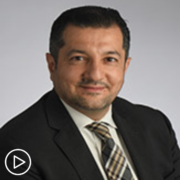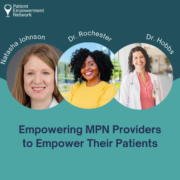Advice for Choosing MPN Therapy: What’s Right for You?
Advice for Choosing MPN Therapy: What’s Right for You? from Patient Empowerment Network on Vimeo.
MPN specialist Dr. Abdulraheem Yacoub reviews factors that determine which treatment is most appropriate for your essential thrombocythemia (ET), polycythemia vera (PV), or myelofibrosis (MF).
Related Programs:

|

How Should You Participate in MPN Care and Treatment Decisions? |

|
Transcript:
Katherine:
As with most conditions, all patients are different, of course, and what might work for one person might not be appropriate for another. So, how do you choose which treatment is right for a patient?
Dr, Yacoub:
Excellent. So, and that’s actually the heart of what we define as the art of practicing medicine and being patient-centric and focused. And patients already have their own wishes and their needs. And everything should start with having a discussion with patients on what is their priority, and what are they trying to achieve.
And we do have to explain to them the tools we have, the interventions that can help them. But we also need to make sure they’re compatible with what they actually want and their goals in life. And sometimes what we doctors want is not exactly what the patients want. So, we always have to remind ourselves that patients are the drivers of their care. And they have the absolute right to be informed and to make informed decisions based on the options we advise them about.
So, that is always a centerpiece of healthcare. And then patients – basically, we defined four pillars of care. We want to control their symptoms, we want to prevent complications, we want to modify the disease so it doesn’t transform, and we want our therapies not to have toxicities, not to have side effects that are worse than the disease.
So, we bring that up to the table. And we also look at the patient. What are their symptoms? What did the disease cause them to be complications?
What is the risk that their cancer is actually going to progress quickly to hurt their lives? And how serious is the therapy we’re recommending? And we need to make sure that there is a good match between what we’re offering and what the disease is manifesting. So, for example, for patients who have a lot of symptoms, but they have low-risk cancer that they can live with for a long time, we focus on symptoms. We focus on treatments that improve their symptoms.
While with patients who have more serious diseases that are eminently life-threatening, we focus on an expedited path to a more aggressive therapy and a bone marrow transplant.
And then we also try to match those therapies with the other patient’s wishes and needs and so forth. So, all these factors are important. We have more tools to try to prognosticate. So, prognosticate is the medical word that we use as forecasting.
We like to forecast the disease or the cancer. We try to predict the patient’s future. Fortunately, we actually have good tools to prognosticate now. We have models or calculators that factor in patients’ features, their symptoms, their age, their blood counts, their bone marrow findings, and their DNA mutations. And it gives us a score, a risk score that can correlate with their life expectancy or their outcomes.
And we use those tools to guide us. So, there’s actually a tool we use to help patients reach that decision. It’s an objective tool to decide how serious is this disease and how seriously we should tackle it. It’s very applicable for patients with myelofibrosis, more sort of the other lower-risk cancers.
Katherine:
What about comorbidities? How do they fit into the treatment plan?
Dr. Yacoub:
Very important.
So, again, it also goes back to finding the balance between how serious is the disease, how serious is the treatment, and how will the patient’s general health tolerate and factor in the choices patients make accordingly. So, myeloproliferative neoplasms do happen in a broad range of ages. And we have children, minors with MPNs, and we have elderly patients with MPNs. And it’s a continuous spectrum. And each individual patient will have their own health concerns and their own health comorbidities and their own wishes. And we always have to make sure that we match our therapies, the disease seriousness, and the patient’s wishes, which is also stemming from their own other health battles, too.
We cannot turn a blind eye to the other health issues going on. That plays a major factor as we choose to discuss bone marrow transplantation with patients. Because that’s when the medical comorbidities are often the first barrier to go through.
Katherine:
Are there specific biomarkers that may affect prognosis or treatment?
Dr. Yacoub:
Yes. So, and we’re glad that actually myeloproliferative neoplasms are actually the model in medical oncology on how predictors can tell us a lot more about the patient’s future about the prognosis. So, early on in MPNs, we’ve developed models, like the International Prognostic Scoring Systems in many different iterations. And more recently, the Molecular Based International Prognostic Scores.
They factor in patient’s age, they factor in blood numbers, they factor in DNA abnormalities, they also factor in DNA mutations, including the common driver mutations JAK2 and CALR and MPL, as well as more novel mutations that we call higher risk mutations.
So, based on these models, we use these tools to predict how the cancer will behave, and how to approach it. This advancement has been an application for our MPN patients for a while, way ahead of all other fields of oncology. So, we’re proud that we can give our patients this tool before all other doctors were able to. Yeah.










